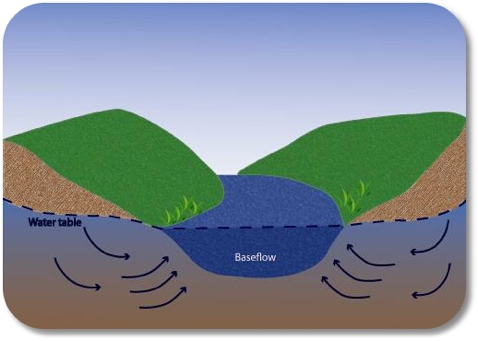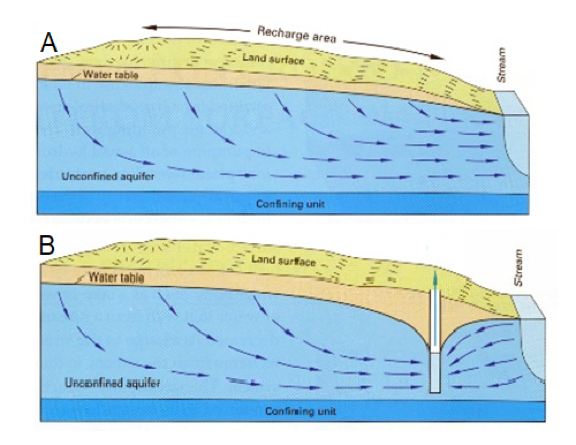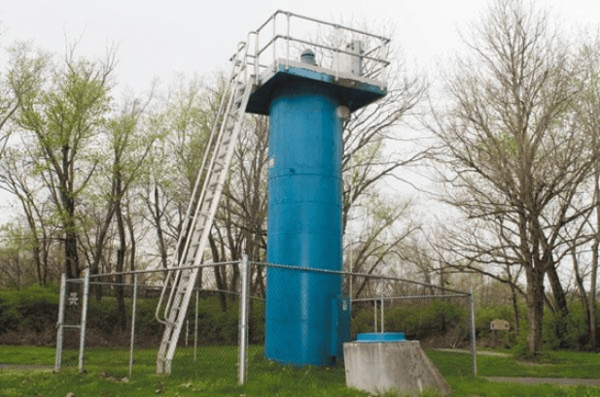One primary goal of the GeoEnvironmental Science Program is to train students in skills and concepts important to protection and assessment of groundwater resources, as well as monitoring and remediation of polluted ground water. An important part of the conceptual foundation which guides hands-on efforts to conserve and restore threatened groundwater supplies is the physical connection between groundwater and surface water, such as streams, lakes, and wetlands.
Throughout much of Ohio and the Midwest, streams, lakes, and wetlands are connected to the groundwater system via a phenomena known as baseflow. Baseflow refers to the flow of groundwater into the bottom (base) of a surface water body. We refer to streams that receive significant baseflow as gaining streams (Figure 1). 
Figure 1: Gaining stream showing baseflow of groundwater into stream bottom.
Baseflow is a very common and widespread phenomenon, and helps prevent many streams from going dry during periods of low rainfall. It also accounts in part for the cooler water found in late summer near the bottoms of the deep pools along a stream's course. The groundwater flowing into the streams from below has an average temperature of about 52oF.
Prolonged dry periods can lower the water table and reverse conditions such that streams and other surface water bodies lose water by flow through the stream bottom into the groundwater system. Humans can cause localized reversal of baseflow in areas of intensive pumping of high-volume water wells supplying municipal drinking water systems. This process, known as induced infiltration, pulls water downward through the stream bottom into the groundwater system and then to nearby municipal water wells (Figure. 2)

Figure 2: A) Gaining stream receiving baseflow. B) High-volume municipal well produces large cone of depression reversing groundwater flow direction near stream and causing induced infiltration.
Surface water and groundwater are interconnected. Due to baseflow, contaminated groundwater can pollute gaining streams. In contrast, induced infiltration can draw contaminated stream water into groundwater system and from there into nearby high-volume municipal water wells. Induced infiltration is facilitated by the reshaping of the water table in a circular area around a pumped water well. In this circular area surrounding the well, the water table is drawn down into a conical form (i.e., cone of depressions). The cone of depression can be large enough to reverse the flow direction of groundwater between the stream and nearby municipal well potentially drawing polluted stream water into the city drinking water supply. Such an event is the focus of the movie and book, A Civil Action, which revolves around a legal case concerning the leukemia deaths of children in a Massachusetts town where induced infiltration appears to have contaminated the city drinking water supply.
In the Hocking College area, towns up and down the Hocking River valley depend exclusively on groundwater to meet the needs of their residents. This includes Lancaster, Logan, Nelsonville, and Athens. Each town has its own high-volume water wells drilled in close proximity to the Hocking River (Figure 3).

Figure 3: High-volume municipal water well near Hocking River at Athens. The raised area in background is a levee along the river. The well head and pump sit atop a raised platform to protect them from river flooding.
These wells produce large cones of depression that drive induced infiltration of Hocking River water. Thus, significant portions of the drinking water supplies for these towns are drawn through the bottom of the river and into the nearby municipal wells.



